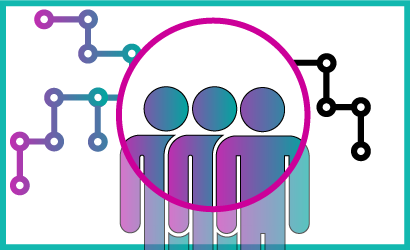

As a social movement in the context of evidence uptake and sustainability establishes and evolves, a core leadership structure is needed to guide the change initiative and provide strategic direction. A core leadership structure may have many names such as a change team, a steering committee, or an implementation team.
In this section, you will learn the diverse skill set required for members of the core leadership structure to be able to work together as a team and also engage colleagues and others in the change initiative (i.e., act as both an inward- and outward-facing team).
What is the key characteristic ‘Core leadership structures’?
A core leadership structure is a group of people whose role is to share the leadership and responsibilities to guide the evolution of a social movement. Leadership is not vested in one person, but across a group of people. Whether the individuals in the core leadership structure are the initial supporters of the shared concern or desired change (i.e., initiators or early adopters) or engage in the change later, all must bring a high level of commitment and energy (Bibby et al., 2009; Blueprints for Change, undated; del Castillo et al., 2016).
A core leadership structure includes formal and informal leaders who work internally as an inward-facing team to support the development and formalization of the social movement.
Activities include:
- planning and visioning,
- building a base of supporters to achieve a critical mass,
- defining priority areas and values,
- positioning issues,
- strategizing for mobilized individual and collective action,
- coordinating resources,
- supporting the development of a collective identity,
- building momentum, and
- sustaining the cause (Bate et al., 2004a; Bibby et al., 2009; Blueprints for Change, undated; del Castillo et al., 2016).
The core leadership structure also works as an outward-facing team striving to engage staff’s active involvement and investment in the change. This is critical as the core leadership team cannot ‘own’ the initiative; they must remain flexible, responsive and open to the input and energy of others for the social movement to grow a critical mass of supporters, gain momentum and evolve (Blueprint for Change, undated).
“If a movement is to have impact it must belong to those who join it, not just those who lead it.”
(Simon Sinek, 2017)
Why is the key characteristic ‘Core leadership structures’ important?
Social movements require energy, planning and strategy. A core leadership structure is central to the social movement’s formation, advancement and maintenance. It ensures the coordination and organization of activities, the availability of time and resources, and the knowledge and experience in social movement thinking and actions (Bate et al., 2004a; Serna-Restrepo et al., 2018).
Without leadership, the social movement will not continue. A key role of the core leadership structure is to build and support a group of individuals who share its leadership. In addition, the team must continue to invest and train new leaders so that the leadership is replenished and maintained (Carson-Stevens et al., 2013; Grinspun et al., 2018b; Tremblay et al., 2018;).
